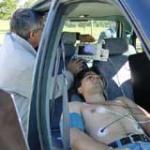Jan 03, 2005
Enhanced intensive care system allows remote access to
FROM THE PRESENCE-L LISTSERV (by Mattew Lombard):
BUFFALO — Lucille Lamarca could feel her heart begin to beat
at a worrisome pace while lying alone in the intensive care unit at
Buffalo General Hospital with a heart condition.
Then from a speaker came a reassuring voice.
"Hi, I'm here," the voice said. "The nurse is on her way. You're
going to be OK."
It was the voice of a doctor who had been keeping an eye on
Lamarca from an office building miles away, via a remote camera
and a bank of computer screens.

The hospital's parent, Kaleida Health System, is among an
expanding number of hospital systems adopting "enhanced
intensive care" technology — known as eICU — that allows
critical care doctors and nurses to monitor dozens of patients at
different hospitals simultaneously, much like an air traffic
controller keeps track of multiple planes.
From the Kaleida control station Monday, health professionals
were monitoring 58 patients at two hospitals via screens that
displayed patients' diagnosis and progress, doctors' notes and
real-time vital statistics like heart rate and blood pressure. The
remote caregivers alerted their onsite counterparts to changes or
potential problems through videoconferencing at the nurses'
stations.
Kaleida, which expects to bring its three other hospitals online in
the spring, stressed the technology is meant to enhance, not
replace, onsite care by allowing doctors to more quickly catch
and respond to trouble.
Kaleida is investing $4 million in personnel and equipment,
officials said.
The technology by Baltimore-based VISICU is in use at least 18
hospital systems nationwide, according to Kaleida, which this
summer became the 9th system to go online.
"I think that it changes the quality of the care in a way that could
not be equaled, even if you doubled or tripled the staffing onsite,"
said Dr. Cynthia Ambres, Kaleida's chief medical officer.
Those familiar with the technology predicted it would become
part of the future of critical care across the country, enabling
hospitals to make the best use of a limited number of intensive
care doctors.
Leapfrog Group, a nonprofit coalition of business and other
groups working to improve hospital operations, has cited a
severe shortage of intensivists practicing in the United States —
less than 6,000 at a time when nearly 5 million patients are
admitted to ICUs each year.
Sentara Healthcare was the first system to install eICU 4 1/2
years ago and now monitors 95 beds at five of its hospitals in
southeastern Virginia and northeastern North Carolina.
Sentara officials estimate the technology allowed them to save
97 lives in 2003, while covering 65 beds.
Instead of relying on a nurse to notice a problem, having her
page a physician and then having that doctor run to the ICU to
make a full evaluation, "all that information is brought to me,"
said Dr. Steven Fuhrman, Sentara's eICU medical director.
"The camera is such that I can count eyelashes," he said,
enabling him to check the patient's ventilator, intravenous
medication and anything else in the room while talking to the
patient and onsite staff.
"It's been described here as being in the room with your hands in
your pocket," Fuhrman said.
Ambres said the in-room cameras, which are not always on, are
seen as reassuring by patients, rather than an invasion of
privacy.
Lamarca, who was hospitalized in August, agreed.
"When you're in the ICU, you're very defenseless and they were
sensitive to that," she said. "I never felt it was an invasion of
privacy," said the Buffalo woman, adding that she could tell by
the position of the camera whether it was on or off.
15:05 Posted in Cybertherapy | Permalink | Comments (0) | Tags: Positive Technology, telemedicine







The comments are closed.